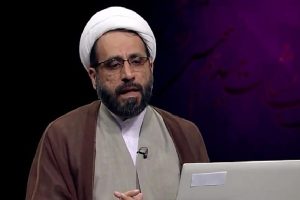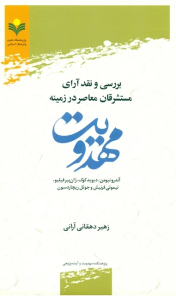“BARRASĪ WA NAQD ĀRĀYE MOSTASHREQĀN MO‘ĀṢER DAR ZAMĪNEYE MAHDAWĪYAT.” [EXAMINATION AND ANALYSIS OF CONTEMPORARY ORIENTALISTS’ VIEWS ON MAHDISM]. By Zohair Dehqani Arani. Qom, Iran: The Islamic Sciences and Culture Academy, 2019. Pp. 364. Paper, 600,000 IRR.
Western scholars who research Eastern studies and Eastern religions, particularly Islam, have historically shown greater interest in certain Islamic topics such as the life of the Prophet Muhammad and the Holy Quran. However, various factors, including the expansion of research, the appeal of the topic, and governmental encouragement, have led to increased attention from Orientalists toward the concept of Mahdism, particularly in the last two centuries.
 Numerous works have been written on Mahdism, and what distinguishes this particular study from others is its impartial and interdisciplinary examination of Western experts’ viewpoints on the Islamic Messiah. The author exhibits comprehensive knowledge and precision in analyzing the subject of Mahdism from the perspective of contemporary Orientalists.
Numerous works have been written on Mahdism, and what distinguishes this particular study from others is its impartial and interdisciplinary examination of Western experts’ viewpoints on the Islamic Messiah. The author exhibits comprehensive knowledge and precision in analyzing the subject of Mahdism from the perspective of contemporary Orientalists.
This work is structured into seven chapters. The first chapter outlines the general discussions, where the author elucidates the research topic, its objectives, necessity, and key terms and concepts. The author indicates that contemporary Orientalists have adopted a different approach to Islamic studies than their predecessors, with this methodological shift resulting in divergent conclusions regarding Mahdism compared to earlier viewpoints.
In the second chapter, the personality and views of Andrew Newman are examined. Some of his significant works are “The formative period of Twelver Shi’ism,” “Twelver Shiism,” and “Safavid Iran”. Primarily, he investigates the history of Iran, particularly during the Safavid era, in which discussions of Mahdism are also referenced. Newman posits in the book of “The formative period of Twelver Shi’ism” on the emergence of Twelver Shi’ism that during the period of minor occultation, Twelver Shi’ah constituted one of the smallest sects. He notes that during the occultation, Shi’i scholars employed rationalist tools derived from Sunni thought (Mu’tazilites) to justify the occultation of the Mahdi in opposition to the hadith-centered Sunni approach. In the book of “Twelver Shiism,” he discusses that after the death of Imam Hasan al-Askari, Twelver Shi’ah experienced significant confusion and division. In his article “Between Qom and the West,” he views the hadiths concerning the duration and nature of the occultation as varied and heterogeneous. According to the author, Newman’s perspective has both positive and negative aspects. Positive aspects include his attempts to engage in theological and historical discussions without bias, his reference to primary Shi’a sources, and his efforts to evaluate Shi’i narratives using criteria employed by Shi’i scholars. However, criticisms of Newman include his imposition of preconceptions on historical events, delving into areas where he lacks expertise, reductionist interpretations lacking a comprehensive view, failure to provide clear criteria for assessing the authenticity and weaknesses of narratives, and neglecting certain historical documents in the analysis of hadith literature and the actions of scholars during the occultation. The author also critiques some of Newman’s views on Mahdism, such as the claim that the foundations of Shi’i Mahdist thought were established by early occultation scholars and the assertion of inconsistencies in certain narratives regarding occultation and uncertainties in the nature and duration of occultation in the hadiths of Al-Kafi.
In the third chapter, the author examines the personality and thoughts of Jean-Pierre Filiu, who has a notable political and scholarly background in France and other Western countries. Some of his significant works include “ les frontières du jihad” (The Borders of Jihad), “ L’apocalypse dans l’islam” (Apocalypse in Islam ), “The Arab Revolution,” “Histoire de Gaza” (Gaza: A history ), “ Le nouvean Moyen-Orient” (The New Middle East), and articles such as “Les quatre fronts d’Al-Qaida” (Four Fronts of Al-Qaeda), “ Al Qaida au Maghreb Islamique; une Logique de Guerre” (The Logic of Al-Qaeda’s War in the Islamic West), “Armagueddon: L’Apocalypse en miroirs” (Armageddon: Apocalypse in Mirrors), and “Au nom de Mahomet” (In the Name of Muhammad). Filiu, similar to many Western writers, considers the adaptation of previous religions and events in early Islam post-Prophet Muhammad’s death as two significant foundations for the apocalyptic outlook among Muslims. He argues that the absence of references to the Antichrist and the Mahdi in the Quran, coupled with the acceptance of these figures among Muslims, represents a contradiction in Islamic eschatological thought. Filiu also addresses the differences between the Shi’i and Sunni messianic perspectives and attributes the formation of Mahdist belief to early Shi’i scholars, including Sheikh Mufid. Additionally, he refers to millenarianism, highlighting similarities between Islam and Christianity and their shared beliefs regarding the apocalypse. With his political activism as a backdrop, he approaches the subject of Islamic eschatological beliefs from this perspective, emphasizing the transformation of Shi’i Mahdism discourse during the Islamic Revolution under Imam Khomeini. Criticisms of Filiu include his predominance of political perspectives and insufficient attention to historical and social dimensions of the discourse, reliance on contemporary sources with minimal references to earlier sources, and a lack of necessary expertise in the field.
In the fourth chapter, the author reviews the personality and views of David Cook. Cook’s extensive research on eschatology and deepening of the contemporary Islamic apocalyptic perspective and its roots have rendered his writings significant within scholarly communities in the West. His key works include “Studies in Muslim Apocalyptic,” “Contemporary Muslim Apocalyptic Literature,” “Messianism in the Shi’i Crescent,” “Islam and Apocalypse,” and “Islamic millenarianism.” He identifies the growth of Islam in Syria, the crossroads of Islam, Christianity, and Judaism, as a crucial factor in the formation of eschatological beliefs but states this does not imply a complete adaptation or lack of originality in Islamic eschatological viewpoints. Cook claims that the primary Islamic source containing Muslim eschatological perspectives is the hadith literature. One of his critical classifications involves distinguishing between historical, hyper-historical, ethical, and messianic perspectives on eschatological hadiths. He asserts that Jesus was initially viewed as the apocalyptic figure, followed by the Mahdi being introduced as a savior. He posits that fatalism and the lack of human agency in the matter of the Mahdi’s emergence is a claim from a Shi’i perspective. Cook views Shi’i apocalyptic thought as a subset of broader Islamic eschatological beliefs that have gained a relatively independent identity due to surrounding events over time. He argues that Mahdism plays a significant role in the political life of the Shi’i world. Regarding the apocalyptic view presented in the Quran, he suggests that it remains relatively underdeveloped, highlighting a profound disjunction between the eschatological framework in the Quran and the prevailing apocalyptic view among Muslims. He discusses the similarities between Islamic and Christian eschatological perspectives, including the emergence of the Antichrist (al-Dajal), the return of Jesus from the heavens, the parallel between the duration of the Sufyani’s rule and the period of labor pains in Christian messianism, as well as the comparisons drawn between the era of peace and tranquility following the appearance of the Mahdi and the expressions found in the scriptures. The author highlights the positive aspects of Cook’s approach, such as his phenomenological methodology in Islamic studies, references to authentic Islamic sources, efforts to clarify ambiguous topics through Muslim perspectives, comprehensive knowledge of the Arabic language, differentiating between various Muslim beliefs, and an overarching view of Islamic messianism. Critiques of him include the failure to employ appropriate methodologies for referencing and examining hadiths and Islamic sources, the lack of comprehensiveness in the phenomenological approach when describing Islamic eschatological perspectives—including narratives—and susceptibility to Western media and unreliable news sources in the analysis of contemporary Muslim beliefs.
 In the fifth chapter, the author explores the personality and views of Timothy Furnish. He is among those Orientalists who possess relatively strong knowledge regarding Islamic beliefs, history, and sects in understanding Islamic messianism. However, due to a selective viewpoint and a historical rather than a phenomenological approach, along with biases and negativity, he has chosen a path of opposition to Mahdism. His significant works include “Holiest Wars,” “Ten Years’ Captivation with the Mahdi’s Camps.” and “ Sects, lies and the Caliphate.” He acknowledges that Mahdism is a core element of Islam and asserts that the Mahdi comes not for a new religion but for the restoration and correction of prophetic teachings and the establishment of peace. He views the belief in Mahdism as a source of extremism and violence and discusses the influences of other religions’ eschatological perspectives on Islamic Mahdism. The author recognizes Furnish’s proficiency in Arabic and Persian, his focus on the subject matter, and a relatively more accurate view of Mahdism in response to current events as positive aspects. The issue that Furnish seeks to establish is the notion that Mahdism poses a danger to the people of the world, while he overlooks the primary objective of Imam Mahdi’s uprising and the establishment of governance, which is the establishment of justice, fairness, and divine sovereignty.
In the fifth chapter, the author explores the personality and views of Timothy Furnish. He is among those Orientalists who possess relatively strong knowledge regarding Islamic beliefs, history, and sects in understanding Islamic messianism. However, due to a selective viewpoint and a historical rather than a phenomenological approach, along with biases and negativity, he has chosen a path of opposition to Mahdism. His significant works include “Holiest Wars,” “Ten Years’ Captivation with the Mahdi’s Camps.” and “ Sects, lies and the Caliphate.” He acknowledges that Mahdism is a core element of Islam and asserts that the Mahdi comes not for a new religion but for the restoration and correction of prophetic teachings and the establishment of peace. He views the belief in Mahdism as a source of extremism and violence and discusses the influences of other religions’ eschatological perspectives on Islamic Mahdism. The author recognizes Furnish’s proficiency in Arabic and Persian, his focus on the subject matter, and a relatively more accurate view of Mahdism in response to current events as positive aspects. The issue that Furnish seeks to establish is the notion that Mahdism poses a danger to the people of the world, while he overlooks the primary objective of Imam Mahdi’s uprising and the establishment of governance, which is the establishment of justice, fairness, and divine sovereignty.
In the sixth chapter, the author evaluates the personality and theories of Joel Richardson. He is among the evangelical writers and preachers who strive to align Islamic eschatology with Biblical prophecies, interpreting positive figures and symbols of Islamic messianism as negative entities and symbols in the Christian Bible. Critiques of Richardson include his specific interpretations of Biblical texts and intra-religious presuppositions forming the basis of his theories, along with his selective referencing of Islamic sources, which serves his claims while ignoring aspects that contradict his assertions. His significant works include “Antichrist: Islam’s Awaited Messiah,” “Why We Left Islam: Former Muslims Speak Out,” “God’s War on Terror,” and ”The Islamic Antichrist.”
In the concluding chapter, the author summarizes his findings regarding the works and opinions of contemporary Orientalists, asserting that they have approached the topic of Mahdism in Islam with a more nuanced perspective than their predecessors. Some scholars have dedicated many years of their lives to this subject, and their works have become reference points for subsequent researchers and authors.
Hossein Baqeri
Tolou International Institute, Qom, Iran
